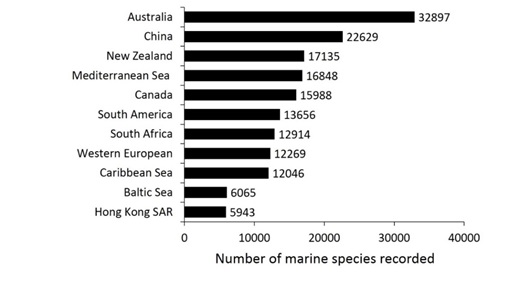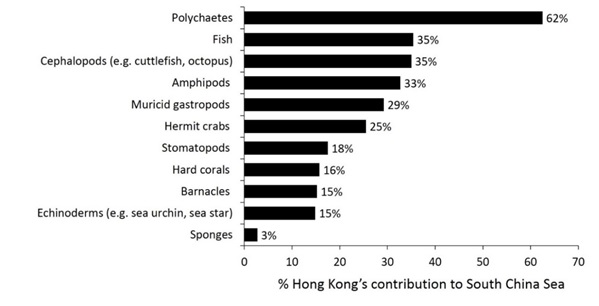Media
Hong Kong hosts more than ¼ of all marine species recorded in China
-HK’s first comprehensive study on marine biodiversity reveals
29 Dec 2016
Hong Kong is best known as a bustling harbour, a financial centre and a shoppers' paradise, with a dense burgeoning population of seven million impacting its natural environment. Yet, away from the skyscrapers and the pressures of anthropogenic influence, Hong Kong has a record of 5,943 marine species according to a recent review by a research group led by Professor Gray A. Williams of The Swire Institute of Marine Science (SWIMS) and School of Biological Sciences, the University of Hong Kong (HKU) (see Figure 1 below). This 1.5-year study funded by the Environment and Conservation Fund (ECF) was published in Biodiversity and Conservation recently.
This first comprehensive review of local marine biodiversity since the beginning of the history of marine science in Hong Kong in 1940s shows that with only about 1,651 km2 marine area (~0.03% of China’s total), Hong Kong already accounts for ~26% of the total marine species recorded in China. As shown in Figure 1, Hong Kong’s marine biodiversity is comparable to many other regions even though its marine area is hundreds to thousands of times smaller than those regions.
Figure 1
“We knew Hong Kong was incredibly rich in its marine species but were still very impressed when we figured out the numbers from the study,” said project manager Dr Terence Ng Pun-tung from HKU SWIMS. The abundance of the territory’s marine biodiversity can be illustrated by simple comparisons - Hong Kong has more hard corals than the entire Caribbean Sea and it also hosts more mangrove tree species than the whole of East Africa. Hong Kong also contributes to a considerable amount (>30%) of the species records for several groups of organisms such as polychaetes, fish, cephalopods and amphipods in the South China Sea, as shown in Figure 2 and 3 below.
Figure 2
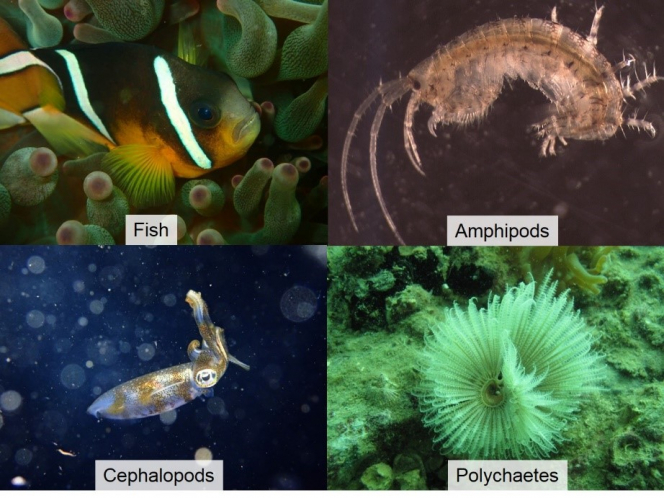
Figure 3 Polychaetes, fish, cephalopods and amphipods found in Hong Kong (Photo credits: Dr Qiu Jianwen, Dr Stella Wong and Mr Gomen See)
These findings reaffirm Hong Kong’s location within the fringes of the world’s marine biodiversity hotspot (i.e. the Western Indo-Pacific region). Hong Kong lies in a transitional geographic position between the temperate and tropical regions, and the mixing of the three ocean currents (Kuroshio, Taiwan and Hainan currents) and suitable climates (‘temperate-like’ winter and ‘tropical-like’ summer), bring together both tropical and temperate species to live in Hong Kong. Apart from that, the influence of complex geology, proximity to the Pearl River (creating an estuarine environment in western waters), a relatively long coastline (1,189 km) and diverse marine ecological habitats suitable for different species to live and interact (see Figure 4 to 7 below) all contributed to mould the highly diverse marine life in Hong Kong.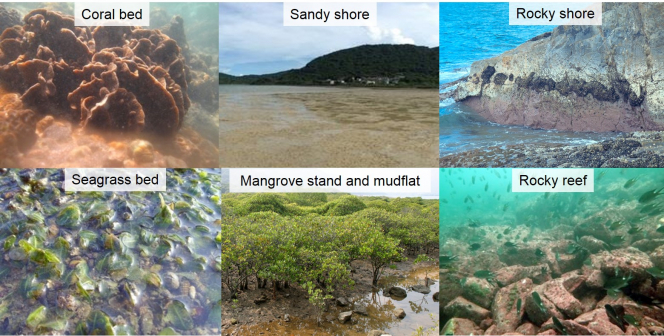
Figure 4 Snapshots of the diverse marine ecological habitats in Hong Kong (Photo credits: Prof Gray Williams, Dr Calton Law and Dr Cynthia Yau)
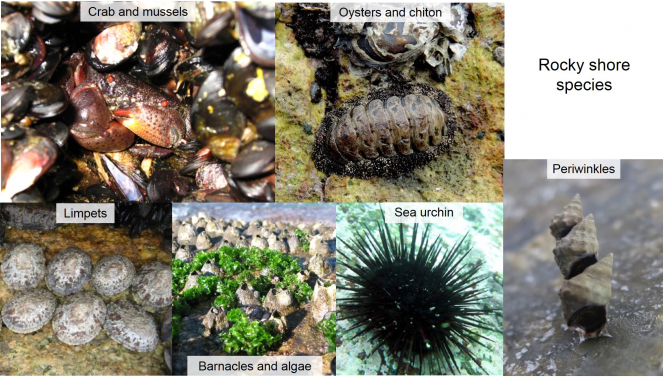
Figure 5 Different ecological habitats host different ranges of species (Photo credits: Prof Gray Williams and Dr Terence Ng)
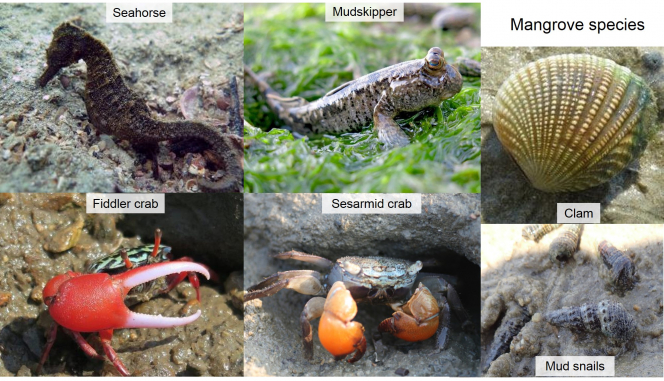
Figure 6 Different ecological habitats host different ranges of species (Photo credits: Dr Stefano Cannicci, Dr Calton Law, Dr Terence Ng and Dr Cynthia Yau)
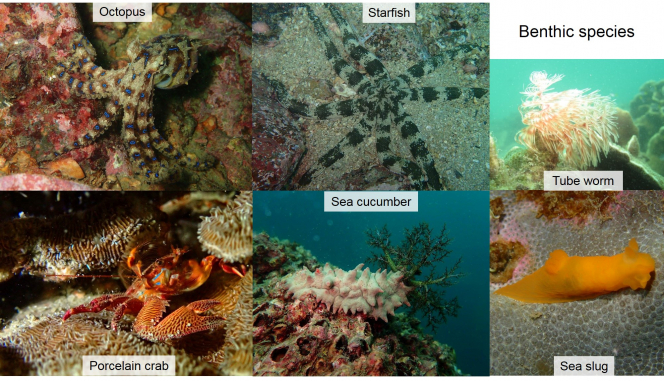
Figure 7 Different ecological habitats host different ranges of species (Photo credits: Dr Qiu Jianwen and Mr Gomen See)
The research team also expected highly diverse marine species in regions near Hong Kong, such as the Philippines, Vietnam and Thailand, but biodiversity information in these regions are largely limited. Given the paucity of knowledge on the marine biodiversity in the Southeast Asia, this study contributes to this knowledge gap and marks a milestone for both Hong Kong and the South China Sea.
“Understanding the number of species we have in our marine environment is a basic need if we are to protect and conserve our biodiversity. This is vital in today’s rapidly changing world, not just here in Hong Kong, but especially in Southeast Asia which holds the world’s most diverse marine habitats. SWIMS is playing a major role in trying to measure and conserve these important resources, both within Hong Kong but also, together with its regional collaborators, in Southeast Asia.” said Professor Gray A. Williams, the leader of this study and the Director of HKU SWIMS.
The enormous array of marine life in Hong Kong, however, has yet to receive its desirable level of conservation as currently only less than 2% of Hong Kong’s marine area is protected as marine parks or reserve as compared with approximately 40 % of our terrestrial area. The Government has committed to designate more new marine parks in the coming years. The Brothers Marine Park in the northern Lantau waters will be soon launched soon, which will bring Hong Kong’s total protected marine area to more than 2%. The research team welcomed the initiative of the new marine park while also urging the Hong Kong government to move towards the global target of at least 10% marine protected area by the year 2020 under United Nation’s Convention on Biological Diversity (CBD) as China is one of the 196 signatories of the Convention and the Convention was extended to Hong Kong in 2011.
Hong Kong launched Asia’s first Register of Marine Species
To establish a platform for the international scientific community to access the marine species in Hong Kong for conservation, research and education purposes, the research team, in collaboration with international experts, has also launched the Hong Kong Register of Marine Species (HKRMS) (see http://www.marinespecies.org/hkrms/) under the umbrella of the largest global marine biodiversity database, the World Register of Marine Species (WoRMS). Hong Kong is one of only ten regions in the world that has such a regional species database, and was the first in Asia. An editorial team consisting of local experts on different taxonomic groups led by Dr Terence Ng has been established to curate and keep the database up-to-date. The HKRMS, therefore, serves as a knowledge exchange platform to showcase the enormous marine biodiversity in Hong Kong.
What’s next?
Hong Kong classes itself as a world city but unlike Singapore and many western countries, it lacks a central repository for its catalogue of marine species, such as a natural history museum or biodiversity centre that collates, manages and analyses and disseminates data of local species. It is, therefore, difficult to confirm the validity of past records and keep track of the status (i.e. changes in species number and distribution under different anthropogenic impacts such as coastal development, pollution, climate change etc.) of our marine resources. The recent launch of Hong Kong’s first Biodiversity Strategy and Action Plan (BSAP) under the CBD, however, provides a unique opportunity for Hong Kong to ‘keep up the pace’.
In light of the BSAP and the future development of SWIMS, the current marine species database will be further developed into an information system to facilitate the sharing of information on marine biodiversity to a wider range of stakeholders, for education, research and conservation purposes.
A spokesman for the Agriculture, Fisheries and Conservation Department (AFCD) welcomed this initiative: “Under the recently launched BSAP, AFCD will explore opportunities to collaborate with local institutions to establish biodiversity centres to disseminate scientific information for the wider community. The Government will work together with external experts to improve sharing of knowledge of biodiversity”.
The SWIMS research team hopes that this initiative will help conserve the incredibly rich, but largely unrecognized, marine diversity of Hong Kong. It also translates into a better protection of our heritage as Hong Kong originated as a fishing village, and we heavily rely on our marine species and habitats for many economic, recreational and aesthetic benefits.
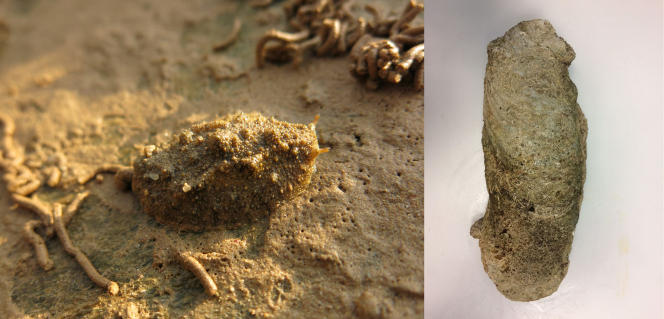
Figure 8 (left) and Figure 9 (right) Around 20 marine species have their species named after Hong Kong – these are two examples: Onchidium hongkongense (left) and Crassostrea hongkongensis (right) (Photo credits: Dr Cynthia Yau (left) and Ms Ginger Ko (right))
The abstract of the article “Hong Kong’s rich marine biodiversity: the unseen wealth of South China’s megalopolis” published in Biodiversity and Conservation is available at
http://link.springer.com/article/10.1007/s10531-016-1224-5
For the powerpoint presentation, please click here.
About SWIMS
The Swire Institute of Marine Science (SWIMS) is a research facility of The University of Hong Kong, situated on the Cape d' Aguilar peninsula, on the shores of Hong Kong's only Marine Reserve. SWIMS aims to:
i. develop an internationally acclaimed research centre focusing on marine science in SE Asia and the NW Pacific;
ii. generate a research culture to train young scientists to an international standard who can play a role in the management and conservation of marine resources in the region;
iii. provide an interdisciplinary research environment to initiate novel research ideas and applications; and
iv. foster research and education links and collaborations with other marine facilities in the SE Asian and global scientific community.
For details, please visit: http://www.swims.hku.hk/
Media enquiries:
SWIMS Professor Gray Williams (Tel: 2809 2179/ 2299 0604; email: hrsbwga@hku.hk);
SWIMS Dr Terence Ng (Tel: 2809 2179; email: tptng@hku.hk)
Communication and Public Affairs Office Ms Rhea Leung (Tel: 2857 8555/ 9022 7446; email: rhea.leung@hku.hk);
Faculty of Science Ms Cindy Chan (Tel: 3917 5286/ 6703 0212; email: cindycst@hku.hk)

